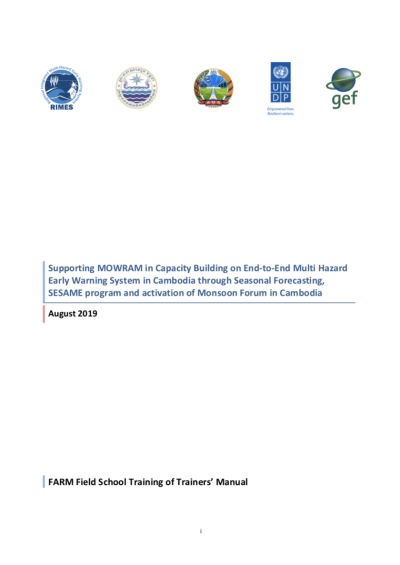
This week, with Min. Agriculture #MAFF & #RIMES, we develop farm school curriculum for #Cambodia, advocating of integration of #climateinformation in agricultural practices. Aim? reducing loss and sustaining life! https://t.co/TLi0QohX0x pic.twitter.com/Mbkskix3Ix
— MuhiUsamah (@muhiusamah) July 4, 2019
Cambodia's Agriculture Ministry estimates that as of June 2017, the sector employs 40% of the country’s population, and contributes about 26.66% of GDP. Rice is the most important product, contributing about half of the agricultural GDP and using an estimated 3.3 million hectares of land. Subsistence agriculture is the main income source for most of the country’s rural population.
Smallholder farmers generally have one rice crop each year, mostly rainfed since cropped area equipped with irrigation is estimated at only 10% of total agricultural production area. The sector is affected by various problems including limited infrastructure, underdeveloped value chains, water resource and land degradation, and plant pests and diseases. It is also highly vulnerable to climate-related hazards like droughts, floods, storms and strong winds.
But while climate poses risks to agricultural production, inter-annual and inter-seasonal variability can also provide valuable resources. This means that information on climate fluctuations could help inform decisions for effective management of farm-related risks and resources.
Designed as a season-long series of interfacing among forecasters, extension workers, and farmers, the FARM School is a multi-tier learning-by-doing capacity building program customized for farmers in specific areas. In general, the FARM School process aims to enhance farmers’ understanding and use of multi- timescale forecasts in farm-level planning and decision-making, thereby increase agricultural production, optimize use of limited resources, and maximize economic benefits.
At the end of the season-long program, farmers will be able to:
- Identify weather, water and climate-related issues and constraints in relation to agricultural production
- Familiarize different weather/climate parameters, terminologies and instruments
- Understand the importance of multi-timescale information (i.e., historical observation, short- , medium- and long-range forecasts as well as climate projections) in farm operations
- Identify appropriate risk and resource management response options
- Utilize location-specific and cost-effective risk and resource management strategies as applicable and necessary to address weather, water and climate-related risks,
- Assess the economic value of integrating multi-timescale information in planning and decision-making
- Document experiences, insights, and good practice cases for dissemination and further adoption
RIMES’ FARM School curriculum and training materials is customized for Cambodia context by technical experts from the General Directorate of Agriculture (GDA), Department of Meteorology (DOM), Agriculture Research Institutes and Extension Office among others. The FARM School Program The season-long FARM School Program is very participatory, practical-oriented and discovery learning- based.
Composed of four parts divided into 11 modules, the program starts with a Training of Trainers (TOT) with experts from relevant agencies, agricultural technicians, extension workers and farmer leaders as participants. Trained agricultural technicians, extension workers and farmer leaders will subsequently train progressive farmers. The latter training may be conducted each season until capacity of all local farmers is enhanced (see Figure 0-1).
The FARM School program is piloted in the provinces of Battambang and Kapong Speu, in the districts of Samroang Torng and Thmor Koul respectively. At least one farmer group is formed for each district/province during the pilot run of the program. This may be scaled up in the next season based on insights, receptivity of relevant agencies and local agriculture staff as well as on availability of resources. FARM School Modules and Sessions The program is comprised of four parts divided into 11 modules with 1-3 sessions per module.
For more information, please contact Mr. Muhibuddin Usamah, Early Warning Systems Project Manager at UNDP Cambodia muhibuddin.usamah@undp.org
About the ‘Strengthening Climate Information and Early Warning Systems in Cambodia’ project
With financing from the Global Environment Facility-Least Developed Countries Fund, the UNDP-supported project ‘Strengthening Climate Information and Early Warning Systems in Cambodia’ aims to increase Cambodia’s institutional capacity to assimilate and forecast weather, hydrological, and climate information for adaptation, disaster preparedness, and early warning. The project has recently completed the installation of 24 automatic weather stations and 24 automatic hydrological stations nation-wide.
